| Mary admires a brand new old-time horse carriage. |
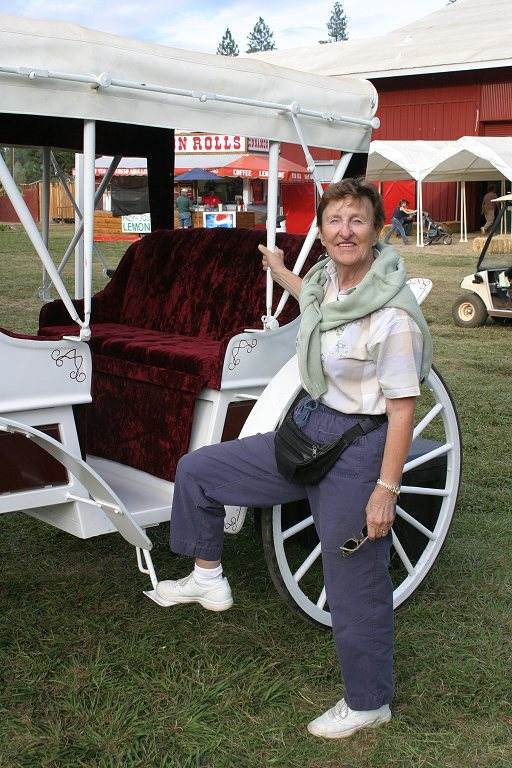 |
Draft Horse Classic, 2004
Photos taken September 17, posted September 21, 2004
© 2004, Herbert E. Lindberg
Note: We attended another Draft Horse Classic event in 2010. Click here to see some of more completely photographed action at this event.
There is little I can add to the extensive media coverage of this most famous and awe-inspiring annual event at the Nevada County Fairgrounds, so this Web page is mainly a family report plus some curmudgeonly comments for local viewers. These comments point out simple changes that could make the show much more enjoyable for grandstand spectators. Spread the word back to the show staff and sponsors if you agree with them.
This year the event spanned September 16-19, 2004, Thursday through Sunday. We went Friday evening rather than the more event-filled Saturday because of guest scheduling difficulty. Still, any day at the Classic is a great day.
Many booths were open on the grounds, but big events like lumberjack sawing were merely set up in preparation for Saturday and Sunday. Mary and I had barbequed beef sandwiches and beer (both excellent) and then wandered the grassy area near the arena. A Canadian manufacturer's representative was displaying modern-day carriages built along traditional lines, for very reasonable prices if we had been in the market.
| Mary admires a brand new old-time horse carriage. |
 |
Farther along toward the arena was a display of "toy" wagons for lucky youngsters living on local horse ranches or farms.
| The perfect gift for that son or daughter on the ranch. |
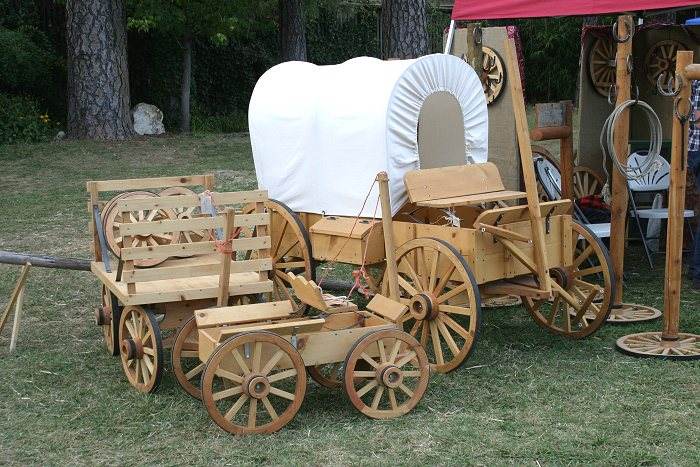 |
At this point it was only a half hour until show time in the arena, so we headed for the draft horse stables to look at the horses, wagons and carts, and a few stars that would appear in the show.
| This Percheron is the picture of calm strength. |
 |
|
These lovely girls later performed acrobatic tricks on their horse. |
 |
| The warm-up event in the arena was this
graceful colt running joyfully with and without his guide. I was amazed to learn that he was only 8 months old. Impressive animals indeed. |
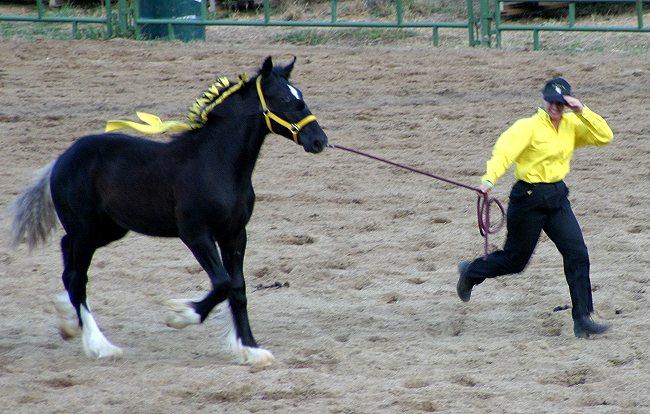 |
The show began with a presentation of colors on a horse-drawn wagon. This wagon, like all others this year and in the past, passed the main grandstand very close to the wall. I took its picture as it passed to demonstrate how thoughtless this is. All one can see from the grandstand is the tops of the wagons and the heads of the horses and riders, and these only sporadically through a sea of heads in the grandstand. If only the wagons were driven about 8 feet farther from the wall, fans in the main grandstand could see them (about 80% of those in attendance!).
|
As has been typical, this wagon was almost entirely |
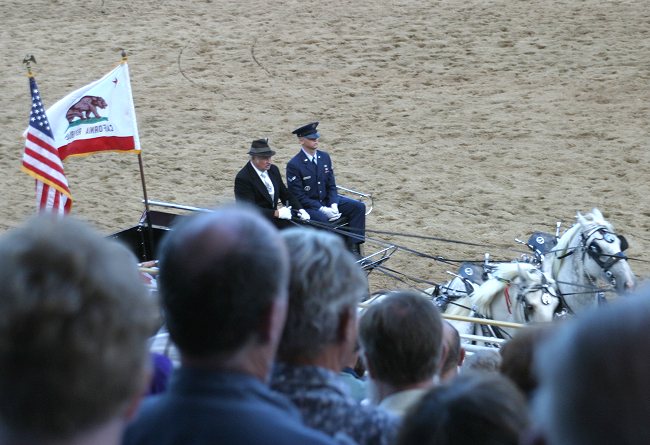 |
When the wagon was on the opposite side of the arena, grandstand spectators could finally see it. However, at this point the wagon, riders, and horses were tiny, unrecognizable blobs in the distance, obscured by a busy background of heads and shiny bleachers. One can see the wagon and horses in the picture below because I took it while fully zoomed at 320 mm with a 35 mm digital camera, and further zoomed the picture digitally during post-processing. With my naked eye I could make out only that 4 white horses were pulling a black wagon with white wheels. Note that the spectators in these much smaller, secondary, bleachers have a clear view over a low cyclone fence and no wall. Are these the families and friends of the participants?
|
Colors presentation wagon pulled at a trot on the opposite side of the arena. |
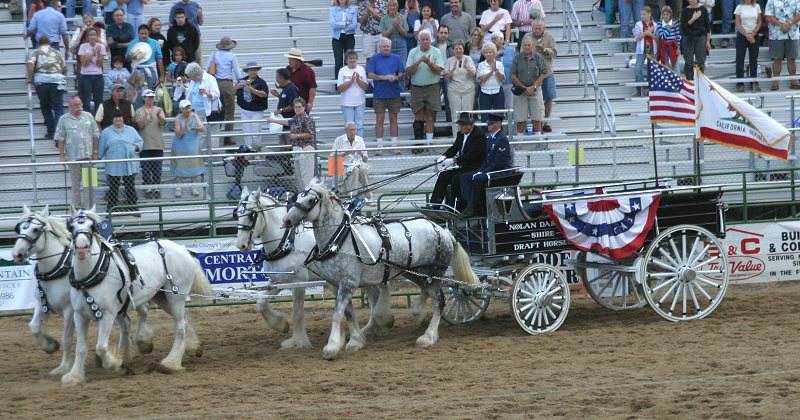 |
Later, the flag presentation wagon came back across the field to the main grandstand. By the time it had turned to present a side view the first pair of horses were again hidden by the wall and heads of the grandstand crowd.
|
Best available view before disappearing again behind the grandstand wall and crowd. |
|
|
The first event was Tandem, which began while there was still sunlight filtered through the gathering rain clouds, just enough light to take a few pictures. I directed my attention to a team from Simpson Percherons driven by Dale Thurow (according to the program) because the horses were dapple gray and more visible in this evening light than the black and brown horses. As Dale drove his team around the end of the arena at a distance from the grandstand wall, I could see his entire rig and horses, if only for an instant and at an angle -- oh that he would have completed his turn at some distance from the wall so we could get a side view at a reasonably close distance. But it wasn't to be. Soon he and his team disappeared behind the wall and sea of heads in the grandstand.
| Dale Thurow from Simpson Percherons in the Tandem event |
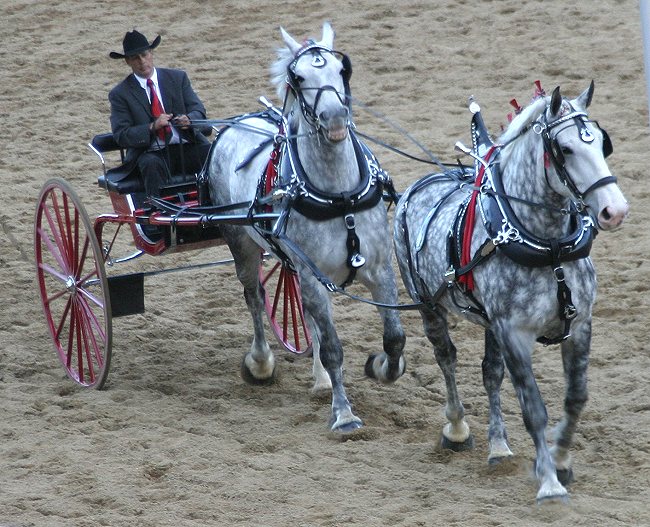 |
Thankfully, half way through each event the teams were asked to cross over the center of the arena in order to reverse directions around its perimeter. During this all-to-brief crossover, each team was again fully visible for an instant, although now so far from the grandstand that they were small images.
|
A tandem team crosses the center of the arena during the direction change. |
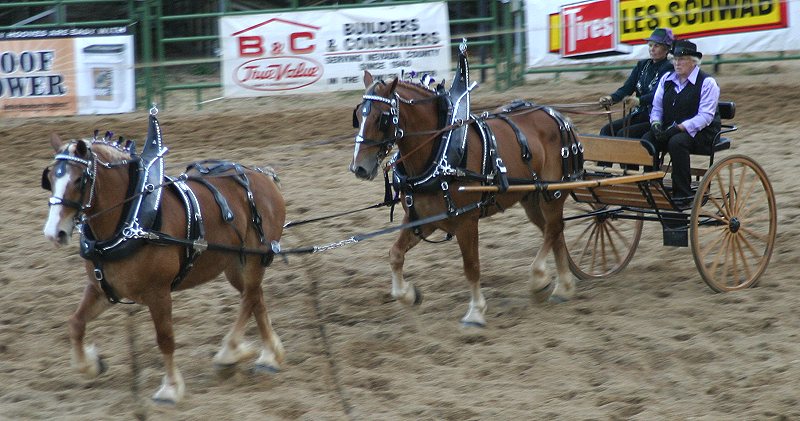 |
| Dale and his team during the crossover |
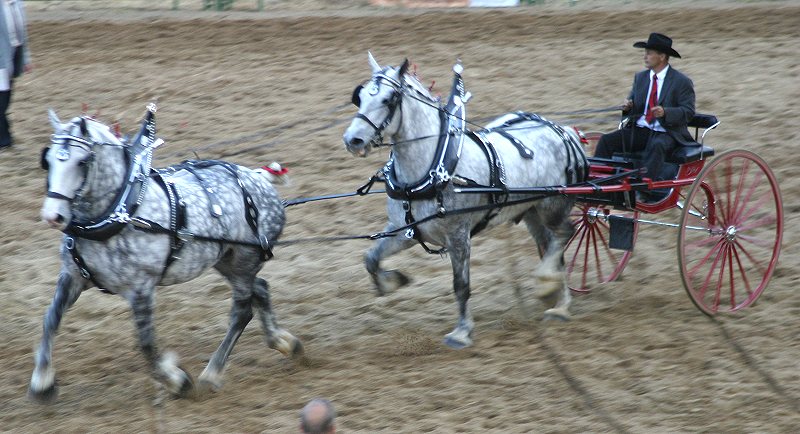 |
Between events a group of young girls performed acrobatic tricks on horseback. By this time the sun had set, so all photographs taken from the grandstand were long exposures under the arena lights. This, combined with having to use telephoto zoom for the performances far out in the center of the arena, resulted in extremely blurred shots. In fact, lighting for all the after-dark events was so marginal that even with binoculars it was difficult to recognize the horses and drivers. Lighting in the center of the arena could be improved by directing some of the lights away from the crowd around the arena and onto the center. The grandstand and bleachers were too bright while the arena center was poorly lighted. The photo below appears to be well lit, but that is the result of a long exposure time and increasing brightness during post-processing.
| A blurred acrobat under poor lighting |
 |
| The poor lighting did force me to take this dramatic picture of action (same girl). |
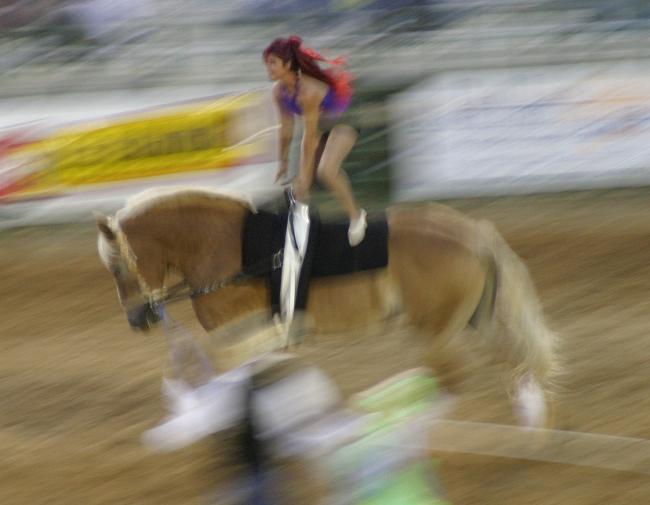 |
While I'm mentioning simple no-cost changes that would greatly improve viewing and enjoyment by the audience, I should mention that there is still a distracting wire that hangs from speaker post to speaker post. This is not nearly as bad as the huge box speakers that were once similarly strung, but is still something that could be eliminated easily. If the wires must be there, put them at the base of the posts with leads that run up to whatever they are connecting.
| Gentlemen pleasure-type singles lined
up for final judging (and the distracting wire and speaker post that cut through them) |
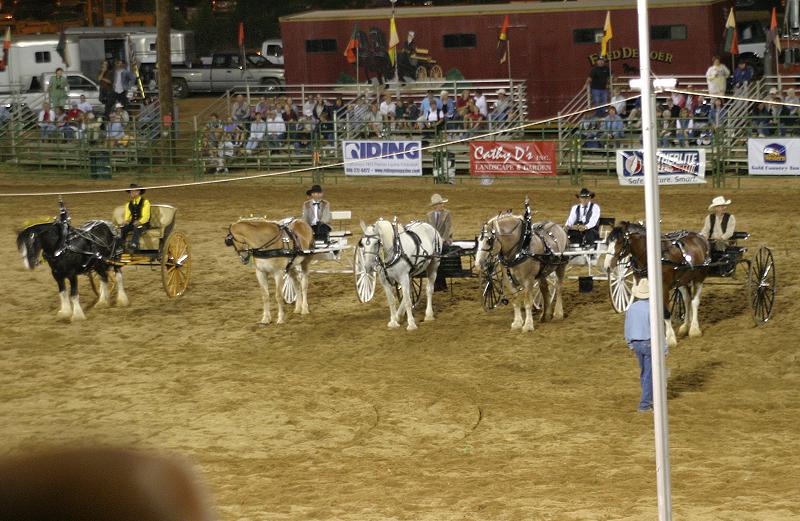 |